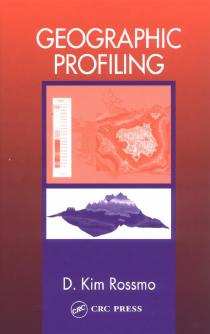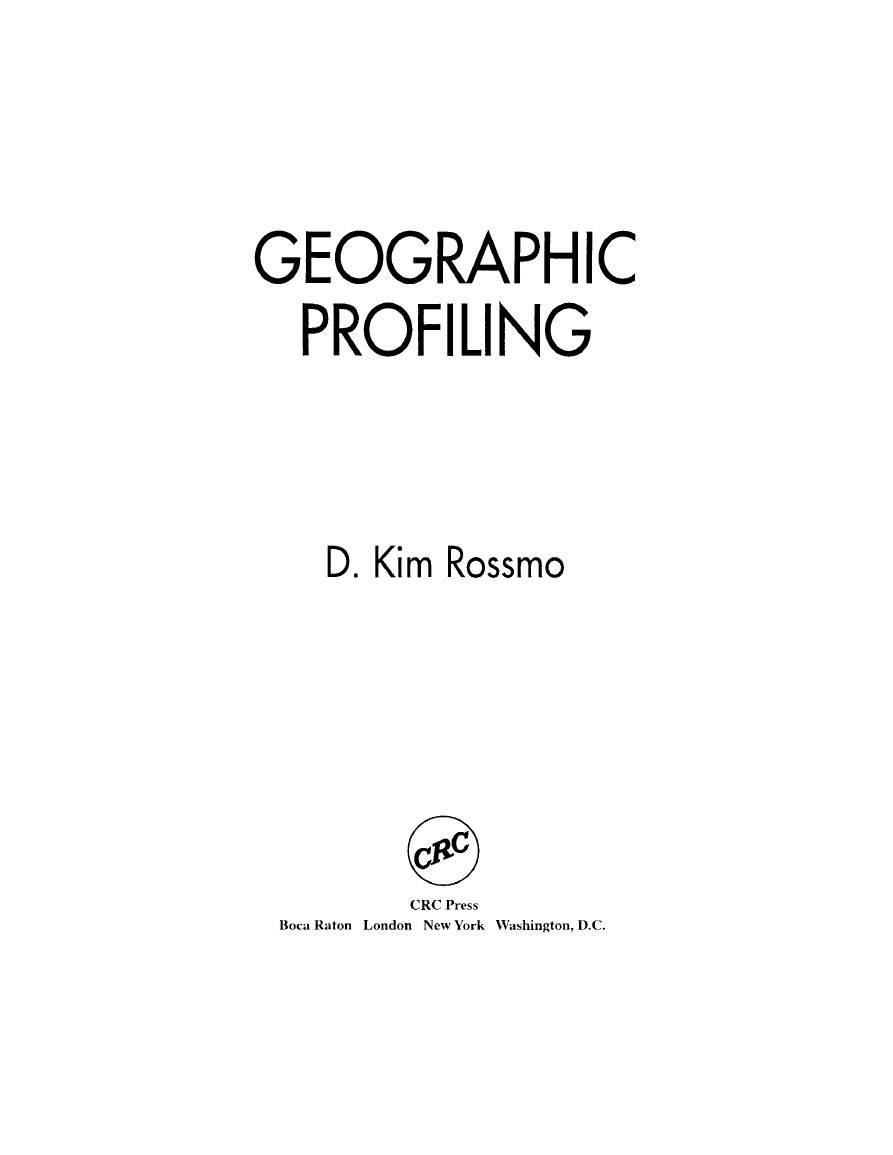EEn
GEOGRAPHIC PROFILING
Back Cover
Foreword
Criminology Comes of Age
Rules That Commute
Environmental Criminology and the Path to Crime Control
Preface
The Author
Acknowledgments
Dedication
Table of Contents
List of Tables
List of Figures
Quotation
Chapter 1: Introduction
Chapter 2: Serial Murder
2.1 Serial Murder
2.1.1 Definitions and Typologies
2.1.1.1 Characteristics
2.1.2 Incidence, Population, and Growth
2.1.3 Theories
2.1.4 Victimology
2.2 Child Murder
2.3 Murder and Distance
Chapter 3: Serial Rape and Arson
3.1 Serial Rape
3.2 Serial Arson
Chapter 4: Forensic Behavioural Science
4.1 Investigative Difficulties
4.2 Police Strategies
4.2.1 Linkage Analysis
4.2.1.1 Physical Evidence
4.2.1.2 Offender Description
4.2.1.3 Crime Scene Behaviour
4.2.2 Other Investigative Tactics
Chapter 5: Criminal Profiling
5.1 Development of Profiling
5.2 Organized and Disorganized Crime Scenes
5.3 Applications of Profiling
5.4 Critiques
5.5 Evaluation Studies
5.6 Profiling and Probability
5.7 Expert Testimony
5.8 Future of Profiling
Chapter 6: Behavioural Geography
6.1 Movement and Distance
6.2 Mental Maps
6.3 Awareness and Activity Spaces
6.3.1 Anchor Points
6.4 Centrography
6.5 Nearest Neighbour Analysis
Chapter 7: Geography Of Crime
7.1 Geography and Crime Studies
7.1.1 Journey-to-Crime Research
7.2 Environmental Criminology
7.2.1 Routine Activity Theory
7.2.2 Rational Choice Theory
7.2.3 Crime Pattern Theory
Chapter 8: Target and Hunt
8.1 Target Patterns
8.1.1 Place and Space
8.1.2 Hunting Grounds
8.1.3 Target Backcloth
8.1.4 Crime Sites
8.1.5 Body Disposal
8.1.6 Learning and Displacement
8.1.7 Offender Type
8.2 Hunting Methods
8.2.1 Target Cues
8.2.2 Hunting Humans
8.2.3 Search and Attack
8.2.4 Predator Hunting Typology
Chapter 9: Predator Patterns
9.1 Spatial Typologies
9.2 Geography of Serial Murder
9.2.1 Methodology
9.2.1.1 Serial Killer Data
9.2.1.2 Newspaper Sources
9.2.1.3 Offender, Victim, and Location Data
9.2.2 Serial Killer Characteristics
9.2.2.1 State Comparisons
9.2.3 Case Descriptions
9.2.3.1 Richard Chase
9.2.3.2 Albert DeSalvo
9.2.3.3 Clifford Olson
9.2.3.4 Angelo Buono and Kenneth Bianchi
9.2.3.5 Peter Sutcliffe
9.2.3.6 Richard Ramirez
9.2.3.7 David Berkowitz
9.2.3.8 Jeffrey Dahmer
9.2.3.9 Joel Rifkin
9.2.3.10 John Collins
9.2.3.11 Aileen Wuornos
9.2.3.12 Ian Brady and Myra Hindley
9.2.3.13 Jerry Brudos
9.4 Serial Murder Characteristics
9.4.1 Offenders
9.4.2 Victims
9.4.3 Locations
9.4.4 Crime Parsing
9.4.5 Clusters
9.4.6 Trip Distance Increase
Chapter 10: Geographic Profiling
10.1 Mapping and Crime Analysis
10.2 Geography and Crime Investigation
10.3 Offender Residence Prediction
10.3.1 Criminal Geographic Targeting
10.3.2 Performance
10.3.3 Validity, Reliability, and Utility
10.3.3.1 Validity
10.3.3.2 Reliability
10.3.3.3 Utility
10.4 Geographic Profiling
10.4.1 Profiling Considerations
10.4.2 Operational Procedures
10.4.2.1 Information Requirements
10.4.2.2 Requesting a Geographic Profile
10.4.3 Understudy Training Program
10.4.4 The Rigel Computer System
Chapter 11: Investigative Applications
11.1 Strategies and Tactics
11.1.1 Suspect Prioritization
11.1.2 Police Information Systems
11.1.3 Task Force Management
11.1.4 Sex Offender Registries
11.1.5 Government and Business Databases
11.1.6 Motor Vehicle Registrations
11.1.7 Patrol Saturation and Stakeouts
11.1.8 Response Plans
11.1.9 Mail Outs
11.1.10 Neighbourhood Canvasses
11.1.11 News Media
11.1.12 Bloodings
11.1.13 Peak-of-Tension Polygraphy
11.1.14 Fugitive Location
11.1.15 Missing Bodies
11.1.16 Trial Court Expert Evidence
11.2 Jack the Ripper
Chapter 12: Conclusion
Appendix A: Serial Murderer Data Set
Appendix B: Data Coding Forms
DATA CODING FORM #1: SERIAL MURDER OFFENDERS
DATA CODING FORM #2: SERIAL MURDER VICTIMS
DATA CODING FORM #3: SERIAL MURDER LOCATIONS
Glossary
Bibliography
















 2023年江西萍乡中考道德与法治真题及答案.doc
2023年江西萍乡中考道德与法治真题及答案.doc 2012年重庆南川中考生物真题及答案.doc
2012年重庆南川中考生物真题及答案.doc 2013年江西师范大学地理学综合及文艺理论基础考研真题.doc
2013年江西师范大学地理学综合及文艺理论基础考研真题.doc 2020年四川甘孜小升初语文真题及答案I卷.doc
2020年四川甘孜小升初语文真题及答案I卷.doc 2020年注册岩土工程师专业基础考试真题及答案.doc
2020年注册岩土工程师专业基础考试真题及答案.doc 2023-2024学年福建省厦门市九年级上学期数学月考试题及答案.doc
2023-2024学年福建省厦门市九年级上学期数学月考试题及答案.doc 2021-2022学年辽宁省沈阳市大东区九年级上学期语文期末试题及答案.doc
2021-2022学年辽宁省沈阳市大东区九年级上学期语文期末试题及答案.doc 2022-2023学年北京东城区初三第一学期物理期末试卷及答案.doc
2022-2023学年北京东城区初三第一学期物理期末试卷及答案.doc 2018上半年江西教师资格初中地理学科知识与教学能力真题及答案.doc
2018上半年江西教师资格初中地理学科知识与教学能力真题及答案.doc 2012年河北国家公务员申论考试真题及答案-省级.doc
2012年河北国家公务员申论考试真题及答案-省级.doc 2020-2021学年江苏省扬州市江都区邵樊片九年级上学期数学第一次质量检测试题及答案.doc
2020-2021学年江苏省扬州市江都区邵樊片九年级上学期数学第一次质量检测试题及答案.doc 2022下半年黑龙江教师资格证中学综合素质真题及答案.doc
2022下半年黑龙江教师资格证中学综合素质真题及答案.doc